The seventh stage became a real test of durability for the vehicles and challenged the crews ability to adapt to the difficult track and constant changes of driving speed. The Kazakhstan team of Astana Motorsports, containing two off-road crews and one truck, successfully completed the stage retaining and even improving their positions in the overall ranking of the race,
Tengrinews reports.
The seventh stage took place on January 12 after a day of rest. It was a distance of 500 kilometers from Salta city of Argentina to the city of Uyuni in Bolivia.
Kazakhstan's car crew of Aidyn Rakhimbayev and Vladimir Demyanenko is still in the Dakar's Top 20 overall after the seventh stage. The crew #342 retained its 13th line in the general ranking finishing the seventh stage in the 23rd place.
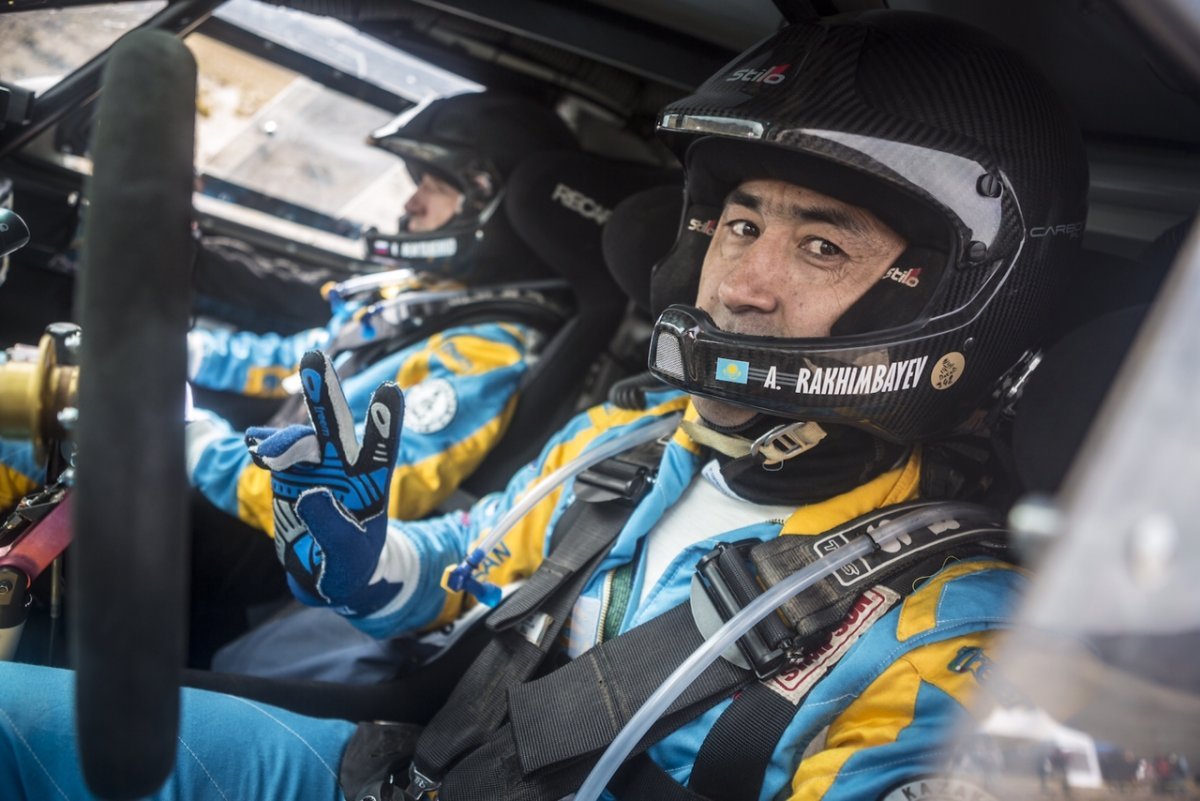
Aidyn Rakhimbayev and Vladimir Demyanenko. Photo courtesy Astana Motorsports.
"We had the longest special section today - 533km. Besides, it was the most high-altitude one: 3500 meters above the sea level and up to the mountain pass at 4100 meters. Things were complicated by the rain that has been pouring for two days. The road became muddy after the rain and had big ditches and scours that were not in the road book, because they just weren't there when the road book was made. Certainly, it was unexpected for us, same as for all the other racers. We 'caught' one of those pits and our car got damaged a little, so we did our best to drive the rest of the route carefully," pilot Aidyn Rakhimbayev shared.
"Wet clay sticking to the tires' treads and making the car hard to manage made driving dangersous. Such complications is combination with the twisted road were very dangerous. Both cars and drivers were lacking oxygen. However advanced the cars were, they were not running uphill smoothly and easily. We felt symptoms of height sickness: dizziness, nausea and restraint. Hypoxia started causing muscle pains.
"At kilometer 317 we landed into a pit, one of those not specified in the road book. The impact was really strong. We damaged the steering gear connection and the steering rack. The wheel geometry was no longer proper and that is where our problems began. We could no longer keep the track at turns and had to reduce our speed, and we were not even sure that we will make it to the finish without more repairs. Before that accident we were overtaking other cars (three cars), but after the accident all we could think about was to lose less time and get to the finish.
"Artur (Ardavichus) flipped over shortly before the finish. But they put the truck back on wheels and he managed to get to the finish.
"Denis (Berezovsky) was also experiencing difficulties: his engine was not generating enough power because of the lack of oxygen and car had problems climbing uphill," Rakhimbayev said.
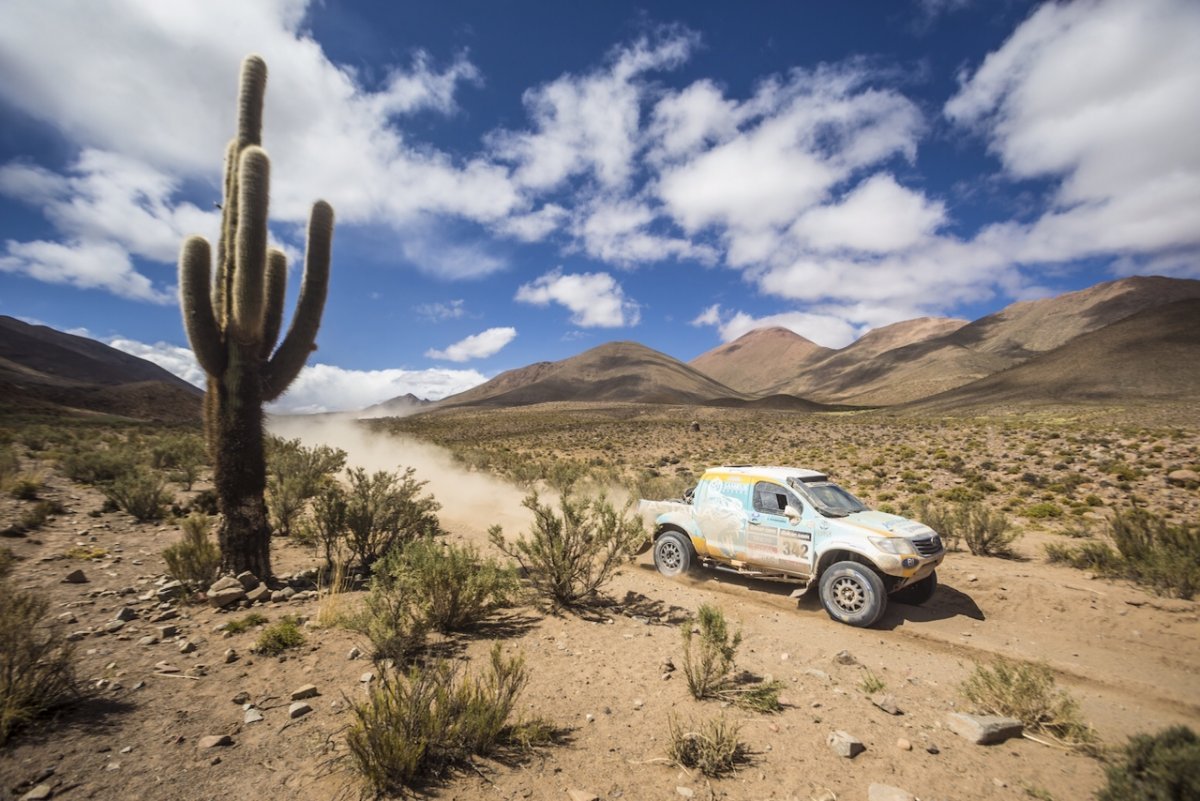
Photo courtesy of Astana Motorsports.
According to Rakhimbayev, the seventh stage was not only the longest one, but also had two heights, 4 thousand meters above the sea level each. However, the crew handled the physical effect of the altitude very well and successfully completed the stage.
The second Kazakhstani off-road crew of Denis Berezovsky and Ignat Falkov (#413) were not an fortunate. They completed the seventh stage in the 60th place and moved down to the 44th place in the overall.
And the crew of bronze winner of Dakar 2012 pilot Arthur Ardavichus advanced to 23th place after the seventh stage in the overall. The crew of pilot Arthur Ardavichus, navigator Alexey Nikizhev and mechanic Radim Kaplanek finished the stage in the 17th place driving the Tatra truck #542.
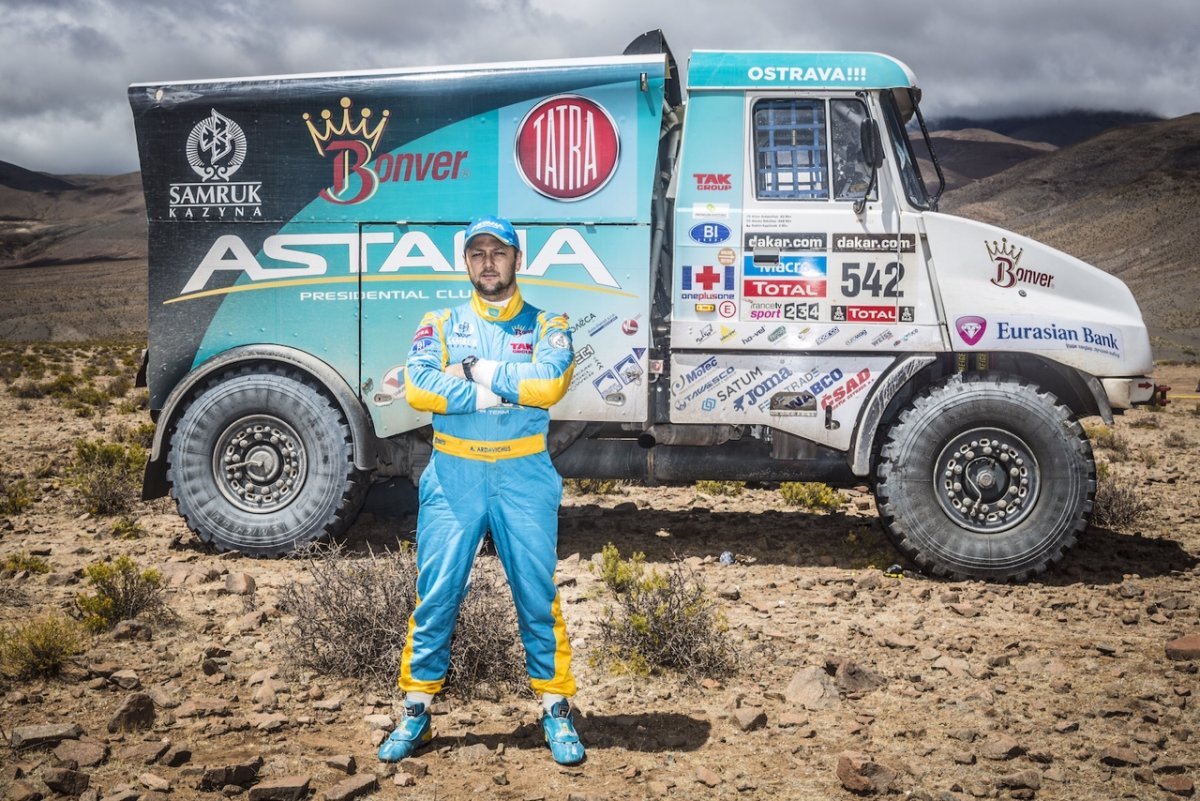
Arthur Ardavichus. Photo courtesy of Astana Motorsports.
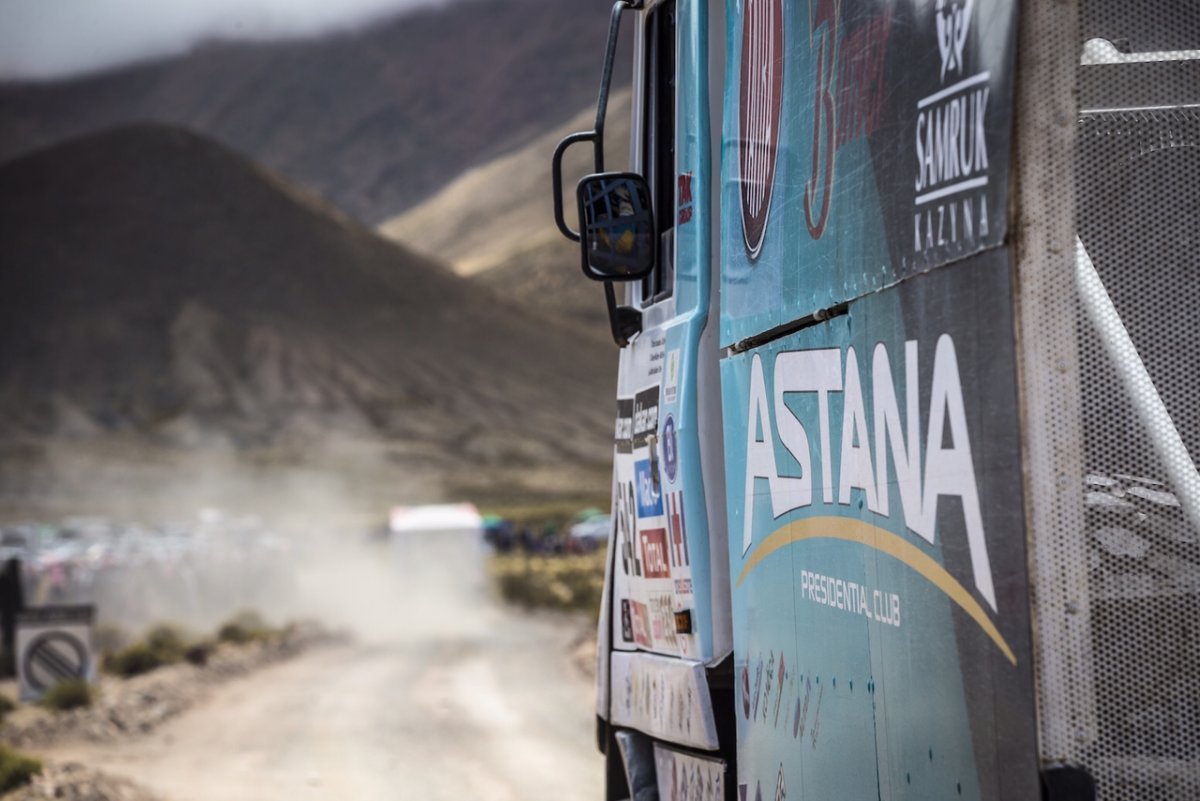
Photo courtesy of Astana Motorsports.
"It was a long day today. The special section was long, high-speed and twisted. Bot the crew and the vehicle were suffering from the lack of oxygen at the altitude of 4 thousand meters. We had to push both the truck and ourselves to the utmost to overcome the altitudes. The truck behaved adequately and the fine-tuning of the engine that we made yesterday enabled us to press forward.
"We had an unpleasant incident when we were speeding at a sharp turn: our vehicle flew off the track and we could not return it back to the right path, because the speed was very high. We crashed and had to stop and fixed the damage to drive to the finish on our own four wheels without the recovery vehicle, because using the recovery vehicle would have meant a withdrawal for us. So, we are not going to get much sleep tonight, we will continue repairing our vehicle together with our team of mechanics to make it ready for the next stage," Kazakhstan's star racer Arthur Ardavichus said.

Arthur Ardavichus. Photo courtesy of the press-service of the Astana Motorsports
Arthur Ardavichus is driving a new Tatra truck at the Dakar 2014. The racer’s main task is to fine-tune the truck, choose the best settings and experiment with different driving techniques to develop the best practices that would unleash the tuck’s potential.
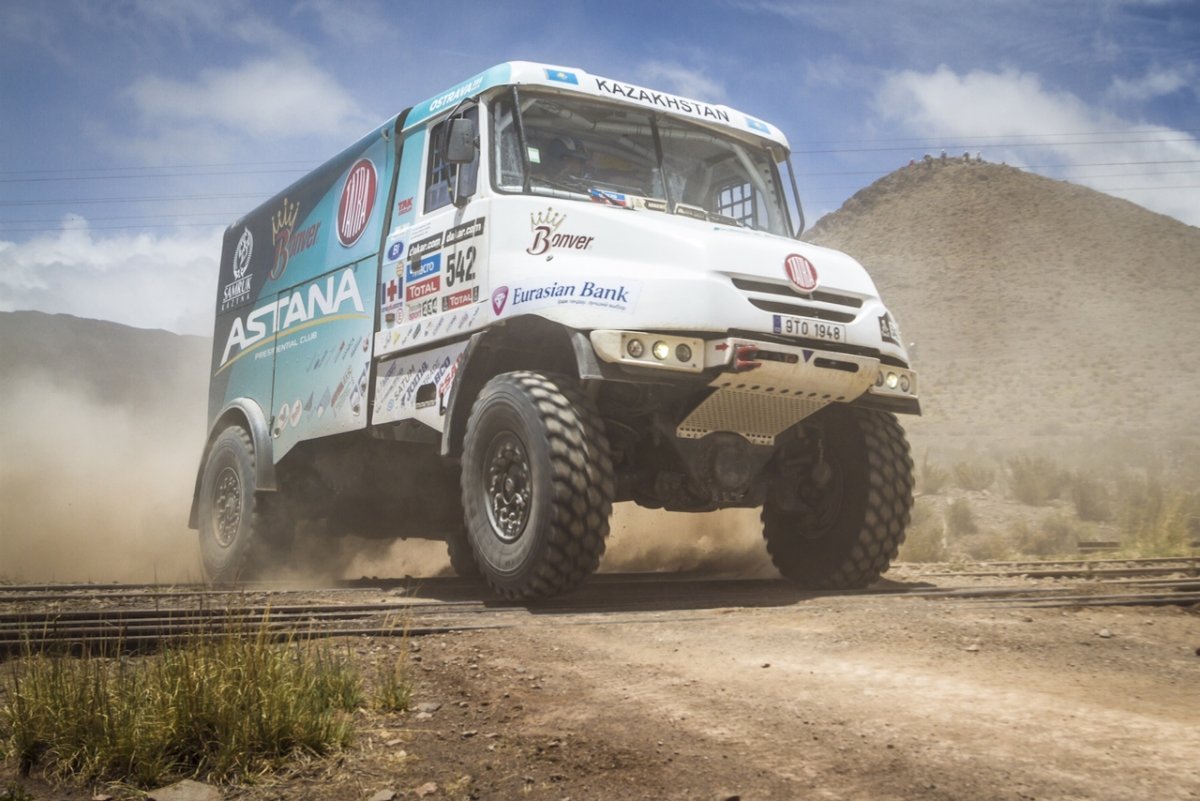
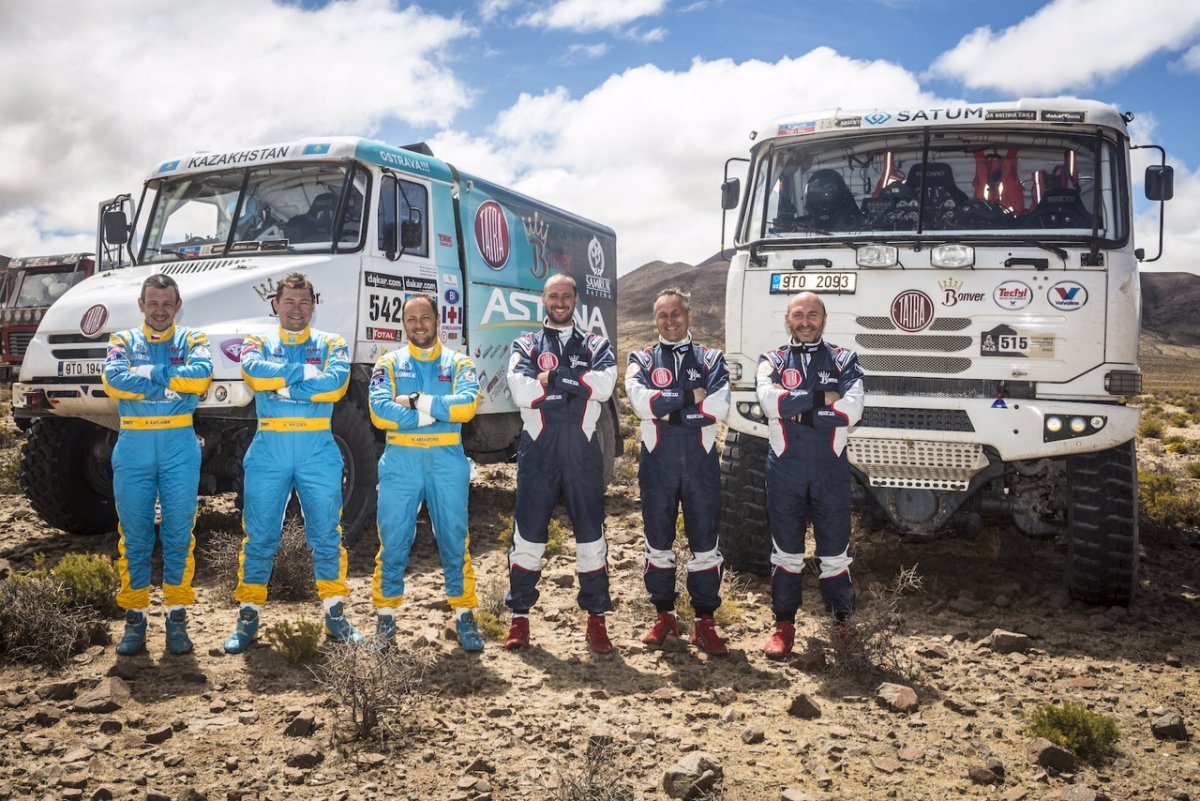
Photos courtesy of Astana Motorsports
There were six more stages awaiting the racers of the transcontinental marathon rally Dakar 2014 after the seventh stage.
 Aidyn Rakhimbayev and Vladimir Demyanenko. Photo courtesy Astana Motorsports.
"We had the longest special section today - 533km. Besides, it was the most high-altitude one: 3500 meters above the sea level and up to the mountain pass at 4100 meters. Things were complicated by the rain that has been pouring for two days. The road became muddy after the rain and had big ditches and scours that were not in the road book, because they just weren't there when the road book was made. Certainly, it was unexpected for us, same as for all the other racers. We 'caught' one of those pits and our car got damaged a little, so we did our best to drive the rest of the route carefully," pilot Aidyn Rakhimbayev shared.
"Wet clay sticking to the tires' treads and making the car hard to manage made driving dangersous. Such complications is combination with the twisted road were very dangerous. Both cars and drivers were lacking oxygen. However advanced the cars were, they were not running uphill smoothly and easily. We felt symptoms of height sickness: dizziness, nausea and restraint. Hypoxia started causing muscle pains.
"At kilometer 317 we landed into a pit, one of those not specified in the road book. The impact was really strong. We damaged the steering gear connection and the steering rack. The wheel geometry was no longer proper and that is where our problems began. We could no longer keep the track at turns and had to reduce our speed, and we were not even sure that we will make it to the finish without more repairs. Before that accident we were overtaking other cars (three cars), but after the accident all we could think about was to lose less time and get to the finish.
"Artur (Ardavichus) flipped over shortly before the finish. But they put the truck back on wheels and he managed to get to the finish.
"Denis (Berezovsky) was also experiencing difficulties: his engine was not generating enough power because of the lack of oxygen and car had problems climbing uphill," Rakhimbayev said.
Aidyn Rakhimbayev and Vladimir Demyanenko. Photo courtesy Astana Motorsports.
"We had the longest special section today - 533km. Besides, it was the most high-altitude one: 3500 meters above the sea level and up to the mountain pass at 4100 meters. Things were complicated by the rain that has been pouring for two days. The road became muddy after the rain and had big ditches and scours that were not in the road book, because they just weren't there when the road book was made. Certainly, it was unexpected for us, same as for all the other racers. We 'caught' one of those pits and our car got damaged a little, so we did our best to drive the rest of the route carefully," pilot Aidyn Rakhimbayev shared.
"Wet clay sticking to the tires' treads and making the car hard to manage made driving dangersous. Such complications is combination with the twisted road were very dangerous. Both cars and drivers were lacking oxygen. However advanced the cars were, they were not running uphill smoothly and easily. We felt symptoms of height sickness: dizziness, nausea and restraint. Hypoxia started causing muscle pains.
"At kilometer 317 we landed into a pit, one of those not specified in the road book. The impact was really strong. We damaged the steering gear connection and the steering rack. The wheel geometry was no longer proper and that is where our problems began. We could no longer keep the track at turns and had to reduce our speed, and we were not even sure that we will make it to the finish without more repairs. Before that accident we were overtaking other cars (three cars), but after the accident all we could think about was to lose less time and get to the finish.
"Artur (Ardavichus) flipped over shortly before the finish. But they put the truck back on wheels and he managed to get to the finish.
"Denis (Berezovsky) was also experiencing difficulties: his engine was not generating enough power because of the lack of oxygen and car had problems climbing uphill," Rakhimbayev said.
 Photo courtesy of Astana Motorsports.
According to Rakhimbayev, the seventh stage was not only the longest one, but also had two heights, 4 thousand meters above the sea level each. However, the crew handled the physical effect of the altitude very well and successfully completed the stage.
The second Kazakhstani off-road crew of Denis Berezovsky and Ignat Falkov (#413) were not an fortunate. They completed the seventh stage in the 60th place and moved down to the 44th place in the overall.
And the crew of bronze winner of Dakar 2012 pilot Arthur Ardavichus advanced to 23th place after the seventh stage in the overall. The crew of pilot Arthur Ardavichus, navigator Alexey Nikizhev and mechanic Radim Kaplanek finished the stage in the 17th place driving the Tatra truck #542.
Photo courtesy of Astana Motorsports.
According to Rakhimbayev, the seventh stage was not only the longest one, but also had two heights, 4 thousand meters above the sea level each. However, the crew handled the physical effect of the altitude very well and successfully completed the stage.
The second Kazakhstani off-road crew of Denis Berezovsky and Ignat Falkov (#413) were not an fortunate. They completed the seventh stage in the 60th place and moved down to the 44th place in the overall.
And the crew of bronze winner of Dakar 2012 pilot Arthur Ardavichus advanced to 23th place after the seventh stage in the overall. The crew of pilot Arthur Ardavichus, navigator Alexey Nikizhev and mechanic Radim Kaplanek finished the stage in the 17th place driving the Tatra truck #542.
 Arthur Ardavichus. Photo courtesy of Astana Motorsports.
Arthur Ardavichus. Photo courtesy of Astana Motorsports.
 Photo courtesy of Astana Motorsports.
"It was a long day today. The special section was long, high-speed and twisted. Bot the crew and the vehicle were suffering from the lack of oxygen at the altitude of 4 thousand meters. We had to push both the truck and ourselves to the utmost to overcome the altitudes. The truck behaved adequately and the fine-tuning of the engine that we made yesterday enabled us to press forward.
"We had an unpleasant incident when we were speeding at a sharp turn: our vehicle flew off the track and we could not return it back to the right path, because the speed was very high. We crashed and had to stop and fixed the damage to drive to the finish on our own four wheels without the recovery vehicle, because using the recovery vehicle would have meant a withdrawal for us. So, we are not going to get much sleep tonight, we will continue repairing our vehicle together with our team of mechanics to make it ready for the next stage," Kazakhstan's star racer Arthur Ardavichus said.
Photo courtesy of Astana Motorsports.
"It was a long day today. The special section was long, high-speed and twisted. Bot the crew and the vehicle were suffering from the lack of oxygen at the altitude of 4 thousand meters. We had to push both the truck and ourselves to the utmost to overcome the altitudes. The truck behaved adequately and the fine-tuning of the engine that we made yesterday enabled us to press forward.
"We had an unpleasant incident when we were speeding at a sharp turn: our vehicle flew off the track and we could not return it back to the right path, because the speed was very high. We crashed and had to stop and fixed the damage to drive to the finish on our own four wheels without the recovery vehicle, because using the recovery vehicle would have meant a withdrawal for us. So, we are not going to get much sleep tonight, we will continue repairing our vehicle together with our team of mechanics to make it ready for the next stage," Kazakhstan's star racer Arthur Ardavichus said.
 Arthur Ardavichus. Photo courtesy of the press-service of the Astana Motorsports
Arthur Ardavichus is driving a new Tatra truck at the Dakar 2014. The racer’s main task is to fine-tune the truck, choose the best settings and experiment with different driving techniques to develop the best practices that would unleash the tuck’s potential.
Arthur Ardavichus. Photo courtesy of the press-service of the Astana Motorsports
Arthur Ardavichus is driving a new Tatra truck at the Dakar 2014. The racer’s main task is to fine-tune the truck, choose the best settings and experiment with different driving techniques to develop the best practices that would unleash the tuck’s potential.

 Photos courtesy of Astana Motorsports
There were six more stages awaiting the racers of the transcontinental marathon rally Dakar 2014 after the seventh stage.
Photos courtesy of Astana Motorsports
There were six more stages awaiting the racers of the transcontinental marathon rally Dakar 2014 after the seventh stage.


